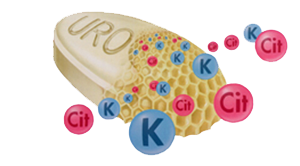|
|
Potassium Citrate REQUIRES AN MD
One can see by the structure, that potassium citrate has many oxygen molecules. The sodium citrate molecule is very similar.
 |
Below are several potassium citrate articles by the Tanners. Their experiments show that an alkalinizing salt of citrate is helpful in slowing the progression of PKD polycystic kidney disease.
Potassium citrate improves renal function in PKD rats 1998
What is potassium citrate? A very effective alkalizer. The above paper is what started it all. This was the first publication on the effectiveness of potassium
citrate in diminishing PKD polycystic kidney disease. Sodium citrate is as effective as potassium citrate. Calcium citrate seems less so. The animals given potassium citrate lived 17 months as
opposed to their counterparts who lived 10 months. Animals fed potassium citrate had smaller cystic kidneys and lived almost twice as long.
Thanks to the continued work of these PKD researchers, taking potassium citrate is now recognized as a possible means of decreasing kidney cysts.
It is an exclusion for participating in Tolvaptan clinical trials as it has been noted there is some evidence that it could help diminish kidney cysts.
Citrate therapy for PKD in rats. 2000
Citrate salts that have an alkalinizing effect preserve kidney functioning and extend survival. Potassium helps. Citrate helps. But it is alkalinity
Dietary citrate treatment of PKD in rats 2003
Starting alkalizing later is not as effective as starting it early.
Dietary potassium citrate does not harm the pcy mouse. 2005
No species of the PKD model was harmed by potassium citrate. Potassium citrate in the feed does not affect the progression of renal cystic disease in the
pcy mouse. This model closely resembles human adolescent nephronophthisis. Potassium citrate has been used for years to effectively treat kidney stones
There are no literature reports of adverse reactions from taking monitored potassium citrate.
George Tanner Bio |
| A few more Potassium Citrate Articles:
Organic potassium salts on mineral balance in rats adapted to an acidogenic diet 2005 France
Alkalinization of the urine is a simple and effective method of treating yeast urinary infections in patients with indwelling catheter. An additional advantage
is the prevention of renal stone formation in immobilized patients.
Alkalinization of urine for yeast candiduria. Oral potassium citrate effective for diminishing yeast infections. 1995 Germany
Effects of potassium citrate supplementation on bone metabolism 2004 Italy
Neutralization Acid Western Diet with Potassium Citrate Increases Bone Mass in Postmenopausal Women Osteopenia 2006
Effects of potassium citrate supplementation on bone turnover in postmenopausal women. 2005 Texas
Nurses' Health Study II those with low urinary citrate levels were prone to hypertension independent of other factors.
Potassium Citrate in Hypertensives lowers blood pressure abstract.
Potassium Citrate in Hypertensives lowers blood pressure full article by American Heart Association.
High citrate diet delays progression of renal insufficiency in the ClC-5 knockout mouse model of Dent's disease.
Potassium citrate therapy significantly alleviated calcium oxalate stone activity, following lithotripsy and among those with residual stones
New stone formation was virtually eliminated with potassium citrate
Potassium citrate useful for treating hypocitraturic stones, calcium stones and uric acid stones
Clinical trial does not justify magnesium as solé therapy for calcium oxalate stones. Addition of potassium citrate reduced stone recurrence by 90%
Polycitra prescribing information
Urocit K prescribing information
Potassium citrate prescribing information.
What is nanobacteria?
"Nanobacteria are unconventional agents 100-fold smaller than common bacteria that can replicate apatite-forming units. Nanobacteria are powerful mediators of biogenic apatite nucleation (crystal form of calcium phosphate) and crystal growth under conditions simulating blood and urine. Apatite is found in the central nidus of most kidney stones and in mineral plaques (Randall's plaques) in renal papilla. The direct injection of nanobacteria into rat kidneys resulted in stone formation in the nanobacteria-injected kidney during one month follow-up, but not in the control kidney injected with vehicle. After intravenous administration in rats and rabbits, nanobacteria are rapidly excreted from the blood into the urine, as a major elimination route, and damage renal collecting tubuli. Nanobacteria are cytotoxic to fibroblasts in vitro. Human kidney cyst fluids contain nanobacteria. Nanobacteria thus appear to be potential provocateurs and initiators of kidney stones, tubular damage, and kidney cyst formation. It is hypothesized that nanobacteria are the initial nidi on which kidney stone is built up, at a rate dependent on the supersaturation status of the urine. Those individuals having both nanobacteria and diminished defences against stone formation (i.e. genetic factors, diet and drinking habits) could be at high risk. Kidney cyst formation is hypothesized to involve nanobacteria-induced tubular damage and defective tissue regeneration yielding cyst formation, the extent of which is dependent on genetic vulnerability."
Some new research points to electron microscope size bacteria known as nanobacteria to be a living buffering system of the body. These tiny bacteria spring into action when the pH of the body turns slightly acidic and they immediately capture acid minerals and form them into stones to further assist the body to maintain a delicate balance of neutral. A theory on nanobacteria, they might possibly be among the oldest very first organisms. They have found nanobacteria on carbon dated old old rocks. They are a cross between mineral and bacteria. Nanobacteria are living pH regulators that exist in this world. They go easily from their worm like form into their rock form. Nano transmit a slim that propels themselves along. If the host body, i.e. our body, becomes too acidic, nanobacteria jump into action and sacrifice themselves changing into a rock like crystal that will bind the body's acids. It is a great protector that helps us to survive; nano is a great help to our bodies; it tries very hard to get us to live; they help us to survive and remain alkaline. That is the purpose of nanobacteria. The do form kidney stones if the body becomes too acidic. They do form placque again if the body is too acidic. If the body is too acidic, then stone formation will easily happen. Nanobacteria senses that the body's pH is becoming dangerously acidic, so it springs into action, changing its form from a worm like secreting slim to a rock. The rock binds all available acids that is possibly can. The body stays alive. The body stays neutral. We can change this by helping our own bodies along and by remaining alkaline. Generally with alkalinity, there will be no stone formation.
|